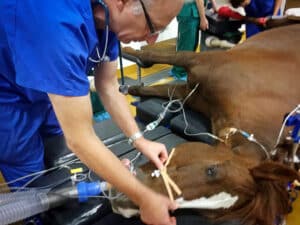Veterinary anaesthetists are veterinarians who undertake further study in order to specialise. JAMIE HOCKING spoke to Dr Anthony Nicholson about his work.
For the past 10 years, Dr Anthony Nicholson has worked at Adelaide University as a teaching veterinarian, researcher and hands-on clinical anaesthetist for small and large animals.
JH: Did you always want to be a veterinary anaesthetist?
AN: Originally I wanted to work with marine mammals. I did a PhD looking at marine mammal lung structure, and became interested in the respiratory system, which is an integral part of general anaesthesia. I was offered a really good anaesthesia internship at UC Davis in California where I worked on many horses and other animals. I’ve been involved with the anaesthesia of every kind of animal from mice to elephants, although more mice than elephants!
JH: In terms of anaesthetic complications, where do horses rate compared to other animals?
AN: Wild animals are certainly challenging as they are hard to handle and restrain before and after procedures. Once I found myself as the anaesthetist for a large adult orangutan in a van, stuck in a traffic jam on a California freeway. So where are horses in relation to that? They’re easier but still right up there; because they’re big animals that can panic and become dangerous to themselves and to the people around them.
They’re also challenging in an anatomical sense. For some procedures, such as CT scans or abdominal surgery, they’re positioned on their backs even though they’re not designed to lie on their backs for extended periods. Because of their shape, their abdomen pushes up against the diaphragm and can potentially collapse the lungs.
JH: What are common procedures where horses have to be fully anaesthetised?
AN: Most commonly it’s for orthopaedic surgery, where bone is being scraped or pinned and joints are involved. I’m also anaesthetising a lot of horses for serious wounds, particularly if tendons are exposed. We put the horse straight into emergency and suture the tendons back together as quickly and cleanly as possible, otherwise the tendon contracts and it’s much more difficult to achieve the best prognosis. And we do a fair amount of emergency colic surgery, which can be challenging because the horses are metabolically unwell and need to be positioned on their backs.
There are other procedures that don’t need full anaesthesia. Advances in equipment, pharmaceuticals and surgical techniques mean we can do more standing procedures under sedation using a surgical stall and local anaesthetic. Laparoscopies, arthroscopies and other procedures are possible using just sedation and local analgesia, but it still depends on the horse’s temperament.

Anaesthetist Dr Anthony Nicholson prepares a horse for surgery (Image by Sarah Hocking).
JH: Which is the riskiest part of anaesthetising a horse?
AN: Starting anaesthesia (induction) can be tricky. We use injectable sedatives and anaesthetics to collapse the horse, before intubating and anaesthetising with gas. Equine hospitals usually have special padded rooms, a swinging wall panel and floor mats to hold and gently drop a horse to the floor without injuries. For me, anaesthetic recovery is definitely the riskiest phase. In fact, research data shows this is the most dangerous time for them and their handlers. A panicked and still groggy horse can inadvertently damage themselves, even break a leg, and hurt their handlers. The horse has no idea where it is or how it got there. Instinct tells them to get out as fast as they can. Controlled sedation helps make them less likely to hurt themselves or others.
The other risk is hypotension and poor oxygenation during anaesthesia, particularly if they’re on their backs. Horses do much better when they’re on their sides. Well-equipped equine hospitals always have padded surgical tables to ensure good blood flow to all tissues. Good blood flow and well-oxygenated muscles will prevent serious muscle damage caused by the sheer weight of the horse.

JH: Do you worry if the surgeon is taking longer than expected?
AN: Duration of a procedure can impact the outcome to a certain extent. If the horse is having problems maintaining good oxygenation or blood pressure, then you want to get them off the table sooner than later. But you and the surgeons have no real control – the surgeons need to do what’s necessary and it can be hard
to predict how long things will take. If it’s going to take another two hours, you can’t say, ‘Time’s up. We have to wake the horse up now’.

Padded surgical tables help to ensure good blood flow to all tissues. (Image by Sarah Hocking).
JH: Is there anything owners can do to make it easier for horses to have procedures?
AN: Good handling and training at home helps. A horse that’s used to different things; calm, happy to have their hooves wrapped in preparation for surgery, always makes it easier and safer for everyone.
JH: What makes your life difficult as an anaesthetist?
AN: Clients can be a little difficult at times. Some say ‘this horse is worth so much money, you have to take special care of it’. They don’t realise we are totally committed to our profession, taking as much special care with the old neddy from down the road, as we do for the $2 million dollar racehorse. Every horse is equally important and will get the best help we can give.
Feature Image: For some procedures, such as CT scans, horses have to be positioned on their backs (Image courtesy Adelaide University).




